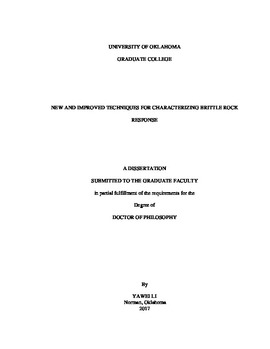| dc.description.abstract | To improve the production from shale, stimulation technique such as hydraulic fracturing with proppants is essential. To maximize the effectiveness of hydraulic fracturing, brittle intervals with the minimum creep deformation are preferable as the target zone. A literature review on rock brittleness evaluation is first conducted to analyze the pros and cons of each assessment method. To capture the Class II behavior of brittle shale, damage-controlled compression test is improved using inelastic strain as the control parameter. Indentation test as a simple and fast brittleness evaluation method is used to indent on four lithologies, the indentation displacement (depth) is considered as the brittleness index; Hydraulic fractures are thought to initiate from tensile fractures, however, currently no brittleness indices are derived from tensile failure. This mismatch of failure mechanism renders existing brittleness indices not representative for application in hydraulic fracturing. To mitigate the mismatch, a new brittleness evaluation method is proposed, that is damage-controlled Brazilian test, brittleness of different lithologies have been measured and compared, Brittle-Ductile Transition and strength envelope are obtained, and fracture angle inclination is observed in different confining pressure.
To assess the contribution of creep to closure rate and conductivity loss
of hydraulic fractures in gas shale, the viscoelastic characteristics of shale have been
investigated. A series of creep tests were conducted on reservoir shale core samples. First, a few uniaxial creep tests were performed on several selected samples, and then multistage triaxial creep tests were carried out at room temperature. Samples used in the tests come from three different gas shale reservoirs. Creep strain can be described by a power-law function of time. The clay and carbonate contents of these shale samples vary noticeably. Results indicate that rocks with more quartz and less clay have higher elastic moduli. Pseudo-steady creep rate increases linearly with deviatoric stress and higher confining pressures increase the amount of creep strain under the same deviatoric stress. Creep tests at elevated temperatures have also been carried out to show that temperature increase creep rate.
The key findings and contribution of this dissertation include:
Indentation test and damage controlled Brazilian test are effective and fast methods to evaluate the brittleness of rocks, the Crack Opening Displacement (COD) can be used as a brittleness index (reverse relation). The indentation depth (displacement) is the brittleness index of indentation test.
An alternative damage (inelastic strain) controlled compression test is developed based on the original method (linear combination of load and displacement). A brittleness formulation ε_p/(ε_r l) is derived based on material characteristic length.
The Brittle-Ductile Transition of tensile failure is first obtained from confined Brazilian test.
Fracture angles in confined Brazilian test progressively increase with confining pressure.
Brazilian discs no longer fail in tensile fracturing under high confining pressure when the minimum principal stress in the middle of the disc is compressive; this provides convincing laboratory evidence for the existence of hybrid fractures that constitute transition from extension to shear fractures.
Clay content and TOC in shale determine their brittleness and creep properties.
For the joint test, multistage compression tests, multistage shear tests and joint stiffness test have been combined to maximize the dataset from one single core plug. | en_US |
